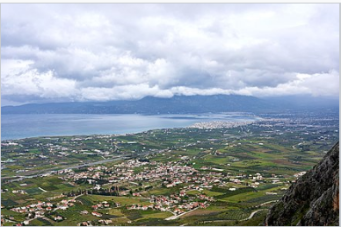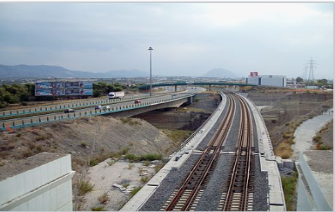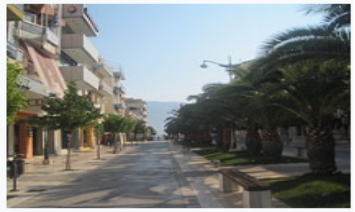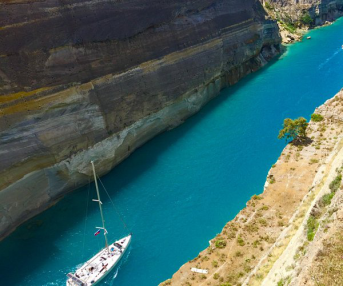Corinth, Corinthia, Peloponnese 作者: 来源: 发布时间:2021-03-01
I. Population, Area and Transportation
Total Area: 102.19 km2 (39.46 sq mi)
Highest Elevation: 10m (30 ft)
Municipal unit density: 370/km2 (970/sq mi)
Population: 58,192(2011)

Roads
Corinth is a major road hub. The A7 toll motorway for Tripoli and Kalamata, (and Sparta via A71 toll), branches off the A8/European route E94 toll motorway from Athens at Corinth. Corinth is the main entry point to the Peloponnesian peninsula, the southernmost area of continental Greece.
Bus
KTEL Korinthias provides intercity bus service in the peninsula and to Athens via the Isthmos station southeast of the city center. Local bus service is also available.
Railways
The city has been connected to the Proastiakos, the Athens suburban rail network, since 2005, when the new Corinth railway station was completed.

Port
The port of Corinth, located north of the city centre and close to the northwest entrance of the Corinth Canal, at 37 56.0’ N / 22 56.0’ E, serves the local needs of industry and agriculture. It is mainly a cargo exporting facility.
It is an artificial harbour (depth approximately 9 metres (30 ft), protected by a concrete mole (length approximately 930 metres, width 100 metres, mole surface 93,000 m2). A new pier finished in the late 1980s doubled the capacity of the port. The reinforced mole protects anchored vessels from strong northern winds.
Within the port operates a customs office facility and a Hellenic Coast Guard post. Sea traffic is limited to trade in the export of local produce, mainly citrus fruits, grapes, marble, aggregates and some domestic imports. The port operates as a contingency facility for general cargo ships, bulk carriers and ROROs, in case of strikes at Piraeus port.
Ferries
There was formerly a ferry link to Catania, Sicily and Genoa in Italy.
Canal
The Corinth Canal, carrying ship traffic between the western Mediterranean Sea and the Aegean Sea, is about 4 kilometres (2.5 mi) east of the city, cutting through the Isthmus of Corinth that connects the Peloponnesian peninsula to the Greek mainland, thus effectively making the former an island. The builders dug the canal through the Isthmus at sea level; no locks are employed. It is 6.4 kilometres (4.0 mi) in length and only 21.3 metres (70 ft) wide at its base, making it impassable for most modern ships. It now has little economic importance.
The canal was mooted in classical times and an abortive effort was made to build it in the 1st century AD. Julius Caesar and Caligula both considered digging the canal but died before starting the construction.[8] The emperor Nero was the first to attempt to construct the canal. The Roman workforce responsible for the initial digging consisted of 6,000 Jewish prisoners of war. Modern construction started in 1882, after Greece gained independence from the Ottoman Empire, but was hampered by geological and financial problems that bankrupted the original builders. It was completed in 1893, but due to the canal's narrowness, navigational problems and periodic closures to repair landslips from its steep walls, it failed to attract the level of traffic anticipated by its operators. It is now used mainly for tourist traffic.
II.Natural Geography (environment and resources)
With a recorded history of nearly five thousand years, Corinth is one of the most historic cities not just in Greece, but also around the globe. By the seventh century BC, Corinth was one of the most advanced Greek city-states. Soon, it became the greatest naval and commercial center of antiquity, establishing several colonies in the region of the Ionian Sea and that of Illyria. However, the Corinthians are best remembered for colonizing large parts of southern Italy, with Syracuse being the most powerful and rich of all the Sicilian colonies.
III. ECONOMY
Corinth grew into a great commercial power thanks to its geographical position near the Isthmus. Using the ship road known as the Diolkos and the city's two ports, Lechaion and Kenchreai, it could control trade both on land and at sea. Trade, the driving force of its economy.

IV. Industrial Characterisitics
Corinth is a major industrial hub at a national level. The Corinth Refinery is one of the largest oil refining industrial complexes in Europe. Copper cables, petroleum products, medical equipment, marble, gypsum, ceramic tiles, salt, mineral water and beverages, meat products, and gums are produced nearby. As of 2005, a period of deindustrialization has commenced as a large pipework complex, a textile factory and a meat packing facility diminished their operations.
V.Attractions
Corinth Canal

The Corinth Canal connects the Gulf of Corinth in the Ionian Sea with the Saronic Gulf in the Aegean Sea.
It cuts through the narrow Isthmus of Corinth and separates the Peloponnese from the Greek mainland, arguably making the peninsula an island. The canal was dug through the isthmus at sea level and has no locks. It is 6.4 kilometres (4 mi) in length and only 21.4 metres (70 ft) wide at its base, making it impassable for many modern ships.
It has little economic importance and is mainly a tourist attraction.The Corinth Canal connects the Gulf of Corinth in the Ionian Sea with the Saronic Gulf in the Aegean Sea. It cuts through the narrow Isthmus of Corinth and separates the Peloponnese from the Greek mainland, arguably making the peninsula an island. The canal was dug through the isthmus at sea level and has no locks. It is 6.4 kilometres (4 mi) in length and only 21.4 metres (70 ft) wide at its base, making it impassable for many modern ships. It has little economic importance and is mainly a tourist attraction.The Corinth Canal connects the Gulf of Corinth in the Ionian Sea with the Saronic Gulf in the Aegean Sea. It cuts through the narrow Isthmus of Corinth and separates the Peloponnese from the Greek mainland, arguably making the peninsula an island. The canal was dug through the isthmus at sea level and has no locks. It is 6.4 kilometres (4 mi) in length and only 21.4 metres (70 ft) wide at its base, making it impassable for many modern ships. It has little economic importance and is mainly a tourist attraction.
VI. History
Corinth derives its name from Ancient Corinth, a city-state of antiquity. The site was occupied from before 3000 BC. But historical sources about the city concerns the early 8th century BC, when Corinth began to develop as a commercial center. Between the 8th and 7th centuries, the Bacchiad family ruled Corinth. Cypselus overthrew the Bacchiad family, and between 657 and 550 BC, he and his son Periander ruled Corinth as the Tyrants. In about 550 BC, an oligarchical government seized power. This government allied with Sparta within the Peloponnesian League, and Corinth participated in the Persian Wars and Peloponnesian War as an ally of Sparta. After Sparta's victory in the Peloponnesian war, the two allies fell out with one another, and Corinth pursued an independent policy in the various wars of the early 4th century BC. After the Macedonian conquest of Greece, the Acrocorinth was the seat of a Macedonian garrison until 243 BC, when the city was liberated and joined the Achaean League. Nearly a century later, in 146 BC, Corinth was captured and was completely destroyed by the Roman army. As a newly rebuilt Roman colony in 44 BC, Corinth flourished and became the administrative capital of the Roman province of Achaea. In 1858, the old city, now known as Ancient Corinth (Αρχαία Κόρινθος, Archaia Korinthos), located 3 kilometres (1.9 miles) south-west of the modern city, was totally destroyed by a magnitude 6.5 earthquake. New Corinth (Nea Korinthos) was then built to the north-east of it, on the coast of the Gulf of Corinth. In 1928 a magnitude 6.3 earthquake devastated the new city, which was then rebuilt on the same site. In 1933 there was a great fire, and the new city was rebuilt again.
VII. Other Information
Corinth, Acrocorinth and Basilica of Lechaion has been part of the Tentative list of Greece.
VIII.Contact Information
Mayor: Dimark
aTel:+30 26610
General State Archives (GSC)
Dafni 61
15452 Psychiko
Phone:+30 210-6782200
FAX:+30 210-6782215
E-mail:archives@gak
